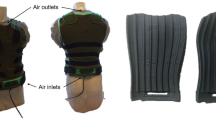Abstract
The present study was conducted in order to evaluate whether physiological strain is alleviated by a new personal cooling system (CS) consisting of a layered vest and integrated blower that generate a flow of air. Twelve male volunteers were exposed to climatic conditions of 40°C, 40%RH (40/40), and 35°C, 60%RH (35/60) during a 115 min exercise routine, followed by 70 min resting recovery, while wearing a battle dress uniform (BDU) and a ballistic vest, with (COOL) or without (NOCOOL) CS. The CS was able to attenuate the physiological strain levels during exercise, when compared to identical exposures without the CS. Temperature elevation, (ΔT re) after 100 min of exercise, was lower by 0.26 ± 0.20 and 0.34 ± 0.21°C in 40/40 and 35/60, respectively, (p < 0.05). Mean skin temperature \( {\left( {\ifmmode\expandafter\bar\else\expandafter\=\fi{T}_{{{\text{sk}}}} } \right)} \) was lower by 0.9 ± 0.4 and 0.6 ± 0.5°C for 40/40 and 35/60, respectively. Heart rate (HR) was not significantly different for COOL versus NOCOOL for 40/40. At 35/60, HR was lower by 10 beats per min (bpm) (p < 0.05). Physiological strain index (PSI) was 9 and 21% lower for the 40/40 and 35/60, respectively, for COOL versus NOCOOL (p < 0.05). Heat storage (S) rates were 19 and 24% lower and sweat rates were 21 and 25% lower for the 40/40 and 35/60, respectively, for COOL versus NOCOOL (p < 0.05). However, the CS was not effective in alleviating physiological strain during resting recovery with no difference in T re cooling rate, S, or HR drop rate between groups over resting recovery periods. The CS tested in this study was found to be an effective tool for lowering physiological strain while exercising but not during resting recovery. Therefore, the CS should be further developed in order to achieve greater attenuation of the thermal strain during exercise and improve effectiveness during rest. Overall, it has the potential to be useful for both military and sports personnel.






Similar content being viewed by others
References
Bruck K (1983) Heat balance and the regulation of body temperature. In: Schmidt R, Thews G (eds) Human physiology. Springer, Berlin
Burton AC (1935) Human calorimetry II. The average temperature of the tissues of the body. J Nutr 9:261–280
Cadarette BS, DeCristofano BS, Speckman KL, Sawka MN (1990) Evaluation of three commercial microclimate cooling systems. Aviat Space Environ Med 61:71–76
Cadarette BS, Cheuvront SN, Kolka MA, Stephenson LA, Montain SJ, Sawka MN (2006) Intermittent microclimate cooling during exercise-heat stress in US army chemical protective clothing. Ergonomics 49:209–219
Epstein Y, Sohar E, Shapiro Y (1995) Exertional heat stroke: a preventable condition. Isr J Med Sci 31:454–462
Færevik H, Le Thi M, Røyset A, Reinertsen RE (2007) The interaction between phase change materials and physiological effector mechanisms. In: International conference on environmental ergonomics. Slovenia
Gao C, Kuklane K, Holmér I (2007) Cooling effect of a PCM vest on a thermal manikin and on humans exposed to heat. In: International conference on environmental ergonomics. Slovenia
Heled Y, Epstein Y, Moran DS (2004) Heat strain attenuation while wearing NBC clothing: dry-ice vest compared to water spray. Aviat Space Environ Med 75:391–396
House JR (1998) Extremety cooling as a method for reducing heat strain. J Def Sci 3:108–114
House JR (2003) Modelling the effectiveness of techniques for reducing heat strain in Royal Navy nuclear, biological and chemical cleansing stations’ teams. J R Nav Med Serv 89:19–26
House JR, Lunt H, Magness A, Lyons J (2003) Testing the effectiveness of techniques for reducing heat strain in Royal Navy nuclear, biological and chemical cleansing stations’ teams. J R Nav Med Serv 89:27–34
Hunter I, Hopkins JT, Casa DJ (2006) Warming up with an ice vest: core body temperature before and after cross-country racing. J Athl Train 41:371–374
McLellan TM, Frim J, Bell DG (1999) Efficacy of air and liquid cooling during light and heavy exercise while wearing NBC clothing. Aviat Space Environ Med 70:802–811
Moran DS, Shitzer A, Pandolf KB (1998) A physiological strain index to evaluate heat stress. Am J Physiol 275:R129–134
Moran DS, Heled Y. Still L, Laor A, Shapiro Y (2004) Assessment of heat tolerance for post exertional heat stroke individuals. Med Sci Monit 10:CR252–257
Pimental NA, Cosimini HM, Sawka MN, Wenger CB (1987) Effectiveness of an air-cooled vest using selected air temperature and humidity combinations. Aviat Space Environ Med 58:119–124
Sawka MN, Wenger CB (1988) Physiological response to acute exercise-heat stress. In: Pandolf KB, Sawka MN, Gonzales RR (eds) Human performance physiology and environmental medicine at terrestrial extremes. Cooper Publishing Group, Massachusettes, pp 97–151
Shapiro Y, Pandolf KB, Sawka MN, Toner MM, Winsmann FR, Goldman RF (1982) Auxiliary cooling: comparison of air-cooled vs. water-cooled vests in hot-dry and hot-wet environments. Aviat Space Environ Med 53:785–789
Smolander J, Kuklane K, Gavhed D, Nilsson H, Holmer I (2004) Effectiveness of a light-weight ice-vest for body cooling while wearing fire fighter’s protective clothing in the heat. Int J Occup Saf Ergon 10:111–117
Vallerand AL, Michas RD, Frim J, Ackles KN (1991) Heat balance of subjects wearing protective clothing with a liquid- or air-cooled vest. Aviat Space Environ Med 62:383–391
Author information
Authors and Affiliations
Corresponding author
Rights and permissions
About this article
Cite this article
Hadid, A., Yanovich, R., Erlich, T. et al. Effect of a personal ambient ventilation system on physiological strain during heat stress wearing a ballistic vest. Eur J Appl Physiol 104, 311–319 (2008). https://doi.org/10.1007/s00421-008-0716-8
Accepted:
Published:
Issue Date:
DOI: https://doi.org/10.1007/s00421-008-0716-8



